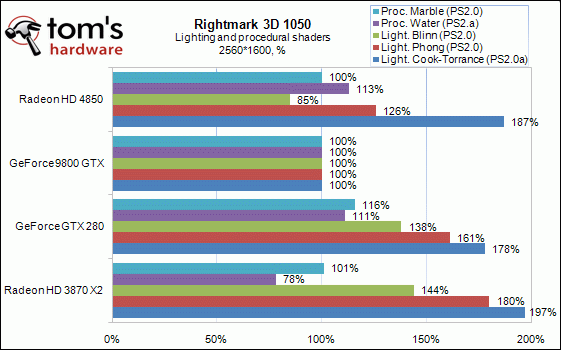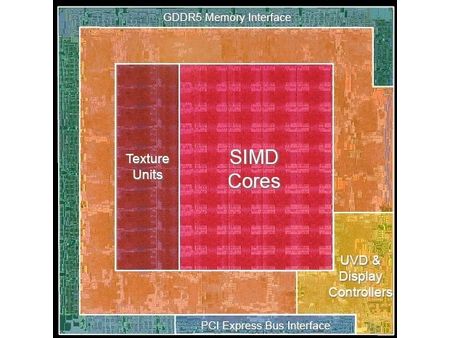ATI Radeon HD 4850: Smarter by Design?
The Radeon HD 4000 Series
That’s far from being a dumb move on AMD’s part. Everyone knows that the bulk of sales isn’t with high-end cards that sell for between $623.61 and $935.39, but with “affordable” ones priced between $233.85 and $467.69. Still it’s a risky move. Though it’s true that card makers earn most of their money with entry-level and mid-level cards, the high end acts as their technological showcase. It’s easier to sell the GeForce 8600 when the 8800 is leading in all the benchmarks than to sell Radeon HD 2600s with the HD 2900’s poor reputation sticking to your shoes, regardless of the intrinsic qualities of the mid-level cards. But before we worry about the future success of this generation for AMD, let’s take a closer look at what the architecture offers.
Radeon HD 4000
| Card | HD 4850 | HD 4870 |
|---|---|---|
| GPU clock frequency | 625 MHz | 750 MHz |
| RAM clock frequency | 993 MHz | 900 MHz |
| ALUs | 800 | 800 |
| Texture units | 40 | 40 |
| ROPs (Raster Operation units) | 16 | 16 |
| Memory controller | 256 bits (8 channel 32 bits) | 256 bits (8 channel 32 bits) |
| RAM type | GDDR3 | GDDR5 |
A new record! With its 160 five-way VLIW shader units (800 ALUs in all), the RV770 dethrones the GT200, with its 993 Mflops to become the first GPU to pass the very symbolic bar of 1 Tflop (1 Tflop for the HD 4850 and 1.2 Tflops for the 4870). But what’s really impressive is for a GPU with a die measuring barely 260 mm² to achieve such figures.
But the pleasant surprises don’t stop there. AMD took advantage of the new architecture – finally, we’re tempted to say – to increase the number of texture units! There are now 40 units, as opposed to only 16 with the R420. Even if that’s still far from Nvidia’s 80 units, the increase is appreciable. In fact, AMD hasn’t abandoned its principles. The number of texture units has increased in proportion to the number of ALUs: Compared to the RV670’s 64 processing units, the RV770 has 160 – a multiplication of processing power by a factor of 2.5 –, and from 16 texture units, the RV670 has been multiplied to 40, by the same factor. So AMD feels that the ratio between arithmetic instructions / texture instructions of 4:1 introduced with its previous architecture was a good balance, and has used it again on this new GPU.
If you compare the competing Nvidia architecture, you see that despite the rebalancing done for the new GT200, the RV770 is still much more at ease with a high number of arithmetic operations. The ratio of processing power/number of texels filtered on this latest GPU from AMD is 40:1 compared to approximately 20:1 for its competitor. Let’s test the differences with our usual theoretical benchmarks. (Note: While the Radeon HD 4870 is the card that would have been best suited for the synthetic tests we use to analyze the architecture, it was unavailable due to the sloppy handling of this launch, with its release dates. So we had no choice but to run them with the HD 4850, and so the performance results are a little less flattering to AMD).

As we did with the GT200, we’ll start off nice and easy, using a version of RightMark 3D with only Pixel Shader version 2.0. The HD4850 actually beat the GTX 280 on the PS2.a and 2.0a tests, but was less at ease with the PS2.0 ones. While it’s easy to understand that the RV770 is better suited for advanced lighting models, we expected it to do better in procedural shader tests where it should be able to take advantage of its enormous processing power.
Get Tom's Hardware's best news and in-depth reviews, straight to your inbox.
Current page: The Radeon HD 4000 Series
Prev Page Introduction Next Page Raw-power and Fill Rate Tests, Continued-
Neog2 Wow $200 in Best Buy for a HD 4850,Reply
$450 in Best Buy for a GTX 260.
And the 4850 is pretty close to the 280.
Ouu the 4870 is going to give Nvidia a run for there money
for the first time in a while. -
Prodromaki Oced Asus and 4850 instead of 4870 + too many games based on engines favoring nVidia...Reply
P.S. +1000 -> 2222 -
For Mass Effect the Engine limits the Maximum framerate to 62FPS. You can change this in the BIOENGINE.INI file (in the Documents\BioWare\Mass Effect\Config\ folder on Vista) by changing the value:Reply
MaxSmoothedFrameRate=62 in the Engine.GameEngine section -
puterpoweruser I can't believe it took nVidia coming out with a new card again to have tom's make a review finally of the 4850.Reply
"it was unavailable due to the sloppy handling of this launch"
Seriously? AMD can't control if their retail partners screwed the pooch on the release date, because they were so anxious to get people this great product. They made sure the product was readily available well before the launch date.
They should be praised for not having a paper launch, not told that it was a sloppy launch, very poor form saying that.
Hell i went to best buy and bought 2 4850's on sunday, when the cards weren't even supposed to be available yet, the guy told me "they have been in stock for over a month in the back, they aren't supposed to be available yet but i can get two for you." Were the AMD police supposed to come and smack best buy on it's hand and keep me from giving them profits?
Sorry if i'm ranting, just put the blame where it belongs. -
Malovane No offense, Fedy Abi-Chahla and Florian Charpentier, and thanks for the hard work, but I think the article should be revised a bit. First off, this should be a review of graphics cards.. not a burned out overclocked Asus motherboard. If you attribute your 4850 test crashing due to your motherboard.. why throw in results of 0 across the board for the 4850? You just corrupted your data and made the final fps averages meaningless, which is the thing people were generally interested in. Secondly, why in the world are you including tests that don't fit the definition of "playable" on any card in your test lineup (Crysis 2560x1600). It just throws off averages, as people aren't going to run this game at 7fps! If there's no card in the lineup that gets close to 30fps in a certain test, just move on! Save it for the quad crossfire or triple sli tests or something. You're giving high weights to resolutions that only a fraction of a percentage point of dedicated gamers can utilize (and those wouldn't bother with a single GPU). Lastly, please get those annoying gigantonormous screenies out of the review. It makes the review look like it was done by kindergarteners.Reply -
puterpoweruser I didn't finish reading the whole article yet but was the driver hotfix and the current 8.6 driver applied to the 4850?? It improved performance and stability greatly as i saw, it make the actual clock speed the card is set it run nicely and gives it great overhead to overclock through the CCCReply -
draxssab Who wants the Radeon 4800 full revew? (including the 4870, that do better than the GTX 280 in some games!)Reply
http://www.hardware.fr/articles/725-8/dossier-amd-radeon-hd-4870-4850.html
In french, but the graphs talk by themselves. Ho, and if you want a short translation = impressive and incredibly more efficient than Nvidia (if you compare the size of the GPU, yes it's A LOT more efficient) -
spaztic7 These reviews are getting better! Although I have seen many benchmarks and tests of the 4850 before this, I still love seeing how the 48x0 line is doing against the green machine! Anandtech.com has a kill 4870 review!Reply
